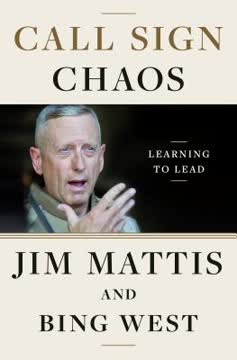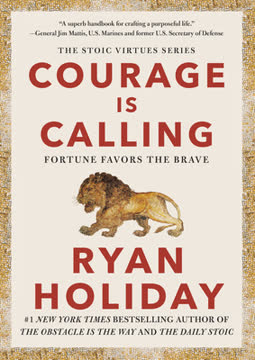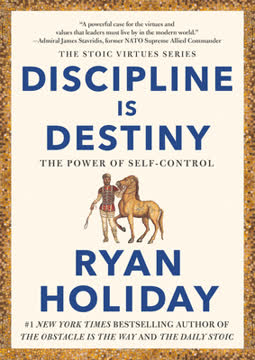Key Takeaways
1. The Warrior Ethos: A code of honor forged in adversity
The Warrior Ethos evolved from the primary need of the spear-toting, rock-throwing, animal-skin-wearing hunting band—the need to survive.
Origins in survival: The Warrior Ethos emerged from the primal need to survive in harsh environments. It developed as a set of principles that bound groups together, fostering cooperation and mutual protection.
Core virtues: This ethos encompasses key virtues such as:
- Courage
- Selflessness
- Loyalty
- Integrity
- Patience
- Self-command
- Endurance
These qualities were essential for the survival of the group and continue to be valued in modern warrior cultures. The ethos also extends beyond external threats, inspiring individuals to confront and defeat internal enemies like envy, greed, and laziness.
2. Shame, honor, and love: Countermeasures to fear
The Warrior Ethos evolved to counter the instinct of self-preservation.
Overcoming fear: Warrior cultures employ three powerful human impulses to counteract the natural instinct of self-preservation:
- Shame
- Honor
- Love
Cultural reinforcement: These concepts are deeply ingrained in warrior societies through:
- Training and discipline
- Rituals and initiation rites
- Stories and legends
- Public recognition and shaming
By emphasizing these values, warrior cultures create a mindset where the fear of dishonor or letting down one's comrades becomes stronger than the fear of death. This psychological shift enables warriors to perform extraordinary feats of bravery and sacrifice.
3. The power of selflessness in warrior cultures
Courage is inseparable from love and leads to what may arguably be the noblest of all warrior virtues: selflessness.
Group over individual: Warrior cultures prioritize the welfare of the group over individual concerns. This mindset is exemplified by the Spartan emphasis on the shield, which protects not just the individual but the entire battle line.
Manifestations of selflessness:
- Sacrificing personal comfort for the good of the unit
- Risking one's life to save comrades
- Sharing limited resources equally
- Putting the mission before personal desires
Selflessness builds trust and cohesion within warrior units, creating bonds that often surpass family ties. This deep connection enables warriors to perform extraordinary feats and face overwhelming odds together.
4. Leading by example: The hallmark of great warriors
Alexander led the charge in person and prided himself on being first to strike the enemy.
The power of personal leadership: Great warrior leaders throughout history have led from the front, inspiring their troops through personal example and shared risk.
Examples of leading by example:
- Alexander the Great charging into battle at the head of his cavalry
- Israeli officers following the principle of "Follow me"
- Marine Corps officers taking pride in sharing hardships with their troops
This leadership style builds trust, respect, and loyalty among warriors. It also demonstrates the leader's commitment to the mission and willingness to face the same dangers as their subordinates, fostering a sense of shared purpose and camaraderie.
5. Embracing adversity: The path to freedom and strength
Better to live in a rugged land and rule than to cultivate rich plains and be a slave.
Strength through hardship: Warrior cultures often arise in harsh environments, viewing adversity as a crucible for developing strength and character.
Benefits of embracing adversity:
- Builds resilience and adaptability
- Fosters independence and self-reliance
- Develops problem-solving skills
- Creates a strong sense of identity and pride
Many warrior societies, from the Spartans to modern special forces units, intentionally create challenging conditions to forge toughness and camaraderie. This mindset of embracing difficulty rather than seeking comfort is a key aspect of the Warrior Ethos that can be applied to personal growth in civilian life as well.
6. Humor as a weapon: Deflecting fear and reinforcing unity
The warrior sense of humor is terse, dry—and dark. Its purpose is to deflect fear and to reinforce unity and cohesion.
Psychological armor: Humor serves as a powerful tool for warriors to cope with the stress and danger of their profession. It helps maintain morale and strengthens bonds between comrades.
Characteristics of warrior humor:
- Terse and understated
- Often dark or macabre
- Inclusive, reinforcing group identity
- Confronts reality without sugarcoating
Famous examples, like Dienekes' quip about fighting in the shade at Thermopylae, demonstrate how humor can simultaneously acknowledge danger while bolstering courage. This use of humor is a subtle yet crucial element of the Warrior Ethos, helping warriors maintain their composure and unity in the face of adversity.
7. The warrior's struggle: External battles and internal wars
Human history, anthropologists say, can be divided into three stages—savagery, barbarism and civilization. Warrior codes arose during the period known as High Barbarism.
Evolution of the Warrior Ethos: While the Warrior Ethos originated in primitive, eye-for-an-eye societies, it has evolved to encompass more noble ideals and internal struggles.
The inner battle:
- Confronting personal vices and weaknesses
- Cultivating self-discipline and integrity
- Striving for personal growth and self-improvement
The Bhagavad-Gita presents a elevated view of the Warrior Ethos, focusing on the internal struggle to become one's best self. This concept bridges the gap between ancient warrior cultures and modern personal development philosophies, showing how warrior virtues can be applied to everyday life and personal growth.
8. Bridging warrior culture and civilian society
The American military is a warrior culture embedded within a civilian society.
Contrasting values: The warrior culture often embraces values that differ from or even contradict those of civilian society, creating potential conflicts and misunderstandings.
Key differences:
- Warrior culture: Cohesion, obedience, sacrifice
- Civilian society: Individual freedom, wealth, comfort
This dichotomy presents challenges for both active-duty military personnel and veterans transitioning to civilian life. Understanding and bridging these cultural differences is crucial for:
- Maintaining a strong, ethical military within a democratic society
- Supporting veterans as they reintegrate into civilian life
- Fostering mutual understanding and respect between military and civilian populations
9. The Warrior Ethos in everyday life: A guide for personal growth
The war remains the same. Only the field has changed.
Universal application: The principles of the Warrior Ethos can be powerful tools for personal growth and success in civilian life.
Warrior virtues in daily life:
- Courage: Facing fears and taking calculated risks
- Discipline: Maintaining focus and perseverance
- Selflessness: Contributing to community and helping others
- Integrity: Upholding personal values and ethical standards
- Resilience: Bouncing back from setbacks and failures
By internalizing these warrior virtues, individuals can develop the strength and character to overcome personal challenges, achieve their goals, and lead more fulfilling lives. The Warrior Ethos, when applied to internal struggles and everyday obstacles, becomes a powerful framework for personal development and success in any field.
Last updated:
FAQ
What's "The Warrior Ethos" by Steven Pressfield about?
- Exploration of Warrior Culture: "The Warrior Ethos" delves into the principles and values that define warrior cultures throughout history, examining both ancient and modern contexts.
- Questions of Honor and Ethics: The book raises questions about the nature of honor, the necessity of a cause for a warrior, and whether a warrior ethos is inherent or cultivated.
- Broader Application: While focused on military personnel, the book suggests that the warrior ethos can be applied to everyday life, helping individuals define and defend their purpose and integrity.
- Personal Observations: Pressfield shares his personal thoughts and observations, aiming to provide insight rather than definitive answers.
Why should I read "The Warrior Ethos"?
- Understanding Warrior Values: The book provides a deep understanding of the values that drive warriors, such as courage, honor, and selflessness.
- Historical Insights: It offers historical anecdotes and stories from various warrior cultures, providing context and depth to the concept of the warrior ethos.
- Practical Application: Readers can apply the principles discussed to their own lives, using them to navigate personal and professional challenges.
- Thought-Provoking Questions: The book encourages readers to reflect on their own values and the role of honor and integrity in their lives.
What are the key takeaways of "The Warrior Ethos"?
- Courage and Honor: Courage, particularly in the face of death, is a central virtue, and honor is a guiding principle in warrior cultures.
- Selflessness and Loyalty: The ethos emphasizes the importance of putting the group before the individual and being loyal to one's comrades.
- Adversity and Resilience: Embracing adversity and enduring hardship are seen as paths to freedom and strength.
- Inner and Outer Battles: The warrior ethos applies not only to external conflicts but also to the internal battles each person faces.
How does Steven Pressfield define the Warrior Ethos?
- Code of Conduct: The Warrior Ethos is a code of conduct that encompasses virtues like courage, honor, and selflessness.
- Cultural and Historical Roots: It is rooted in the traditions of ancient warrior societies, such as the Spartans and Macedonians.
- Adaptability: The ethos is adaptable, applicable to both literal warfare and metaphorical battles in everyday life.
- Moral Framework: It provides a moral framework for individuals to navigate challenges and make ethical decisions.
What are some of the best quotes from "The Warrior Ethos" and what do they mean?
- "Come back with this or on it." This Spartan saying emphasizes the importance of honor and courage, even in the face of death.
- "The greatest counterpoise to fear is love." This highlights the role of camaraderie and brotherhood in overcoming fear in battle.
- "The will to victory may be demonstrated in places other than actual battle." This suggests that the warrior ethos can be applied to various aspects of life, not just warfare.
- "The hardest thing in the world is to be ourselves." This reflects the internal struggle for self-knowledge and authenticity, a key theme in the book.
How does "The Warrior Ethos" relate to modern life?
- Everyday Battles: The book suggests that everyone faces battles in their personal and professional lives, where the warrior ethos can be applied.
- Integrity and Purpose: It encourages readers to define and defend their sense of purpose and integrity, much like a warrior.
- Adversity as Growth: Embracing challenges and adversity is seen as a way to grow and strengthen one's character.
- Community and Support: The ethos emphasizes the importance of community and support, drawing parallels to modern teamwork and collaboration.
What role do women play in "The Warrior Ethos"?
- Spartan Women: The book highlights the strength and courage of Spartan women, who were integral to the warrior culture.
- Support and Resilience: Women are portrayed as pillars of support, whose resilience inspires and sustains the warrior spirit.
- Cultural Foundation: The ethos is not solely a manifestation of male aggression but is supported by the will and resolve of women.
- Historical Examples: Stories of Spartan mothers and wives illustrate the critical role women played in maintaining the warrior ethos.
How does "The Warrior Ethos" address internal conflicts?
- Inner Enemies: The book discusses the internal enemies each person faces, such as fear, greed, and selfishness.
- Self-Discipline: It emphasizes the importance of self-discipline in overcoming these internal battles.
- Spiritual Guidance: Drawing from texts like the Bhagavad-Gita, the book suggests that the warrior ethos can guide individuals in their spiritual and personal growth.
- Alignment with Higher Self: The ethos encourages aligning one's actions with their higher nature and values.
What historical examples does Steven Pressfield use in "The Warrior Ethos"?
- Spartan Stories: The book includes numerous anecdotes from Spartan culture, illustrating their values and practices.
- Alexander the Great: Pressfield discusses Alexander's leadership and his application of the warrior ethos in his campaigns.
- Ancient Battles: Examples from battles like Thermopylae and Plataea are used to highlight the principles of courage and honor.
- Cultural Comparisons: The book compares various warrior cultures, such as the Masai, Apache, and Pashtun, to explore common themes.
How does "The Warrior Ethos" differentiate between warrior cultures and criminal organizations?
- Honor vs. Shadow Honor: Warrior cultures operate by a code of honor, while criminal organizations may have a pseudo or shadow version of this code.
- Respect for the Enemy: True warrior ethos mandates respect for the enemy, unlike criminal groups that dehumanize opponents.
- Moral Boundaries: Warrior cultures have moral boundaries that criminal organizations often violate.
- Purpose and Values: The ethos is rooted in noble purposes and values, whereas criminal organizations prioritize self-interest and power.
What is the significance of "purity of the weapon" in "The Warrior Ethos"?
- Moral Use of Force: "Purity of the weapon" refers to the moral use of force, ensuring actions are just and ethical.
- Israeli Defense Forces: The concept is taught to soldiers in the Israeli Defense Forces, emphasizing restraint and moral judgment.
- Guiding Principle: It serves as a guiding principle for warriors to evaluate their actions and maintain integrity.
- Long-term Perspective: The ethos encourages looking beyond immediate conflicts to potential future alliances and reconciliation.
How does "The Warrior Ethos" address the transition from military to civilian life?
- Adapting Skills: The book suggests that the skills acquired in the military, such as discipline and resilience, are valuable in civilian life.
- Identity and Purpose: It addresses the challenge of finding identity and purpose after leaving the military.
- Continued Application: The warrior ethos can continue to guide individuals in their personal and professional endeavors.
- Support and Community: The importance of finding a supportive community and maintaining connections is emphasized for a successful transition.
Review Summary
The Warrior Ethos received mixed reviews. Some praised its concise exploration of warrior values and found it inspiring, while others criticized its glorification of Spartan culture and lack of historical accuracy. Positive reviewers appreciated Pressfield's insights on courage, discipline, and honor, finding applications beyond the military. Critics argued the book oversimplified complex issues and promoted outdated ideals. Many noted its brevity and accessibility. Overall, readers' opinions seemed influenced by their pre-existing views on warrior culture and military ethics.
Similar Books










Download PDF
Download EPUB
.epub digital book format is ideal for reading ebooks on phones, tablets, and e-readers.










